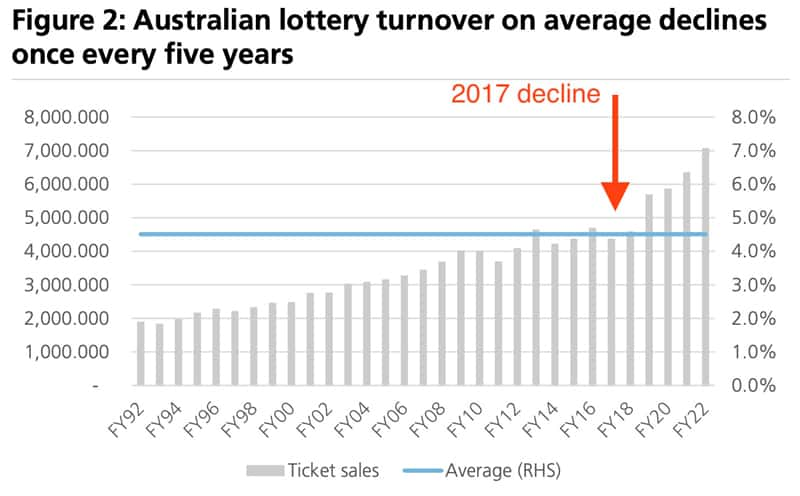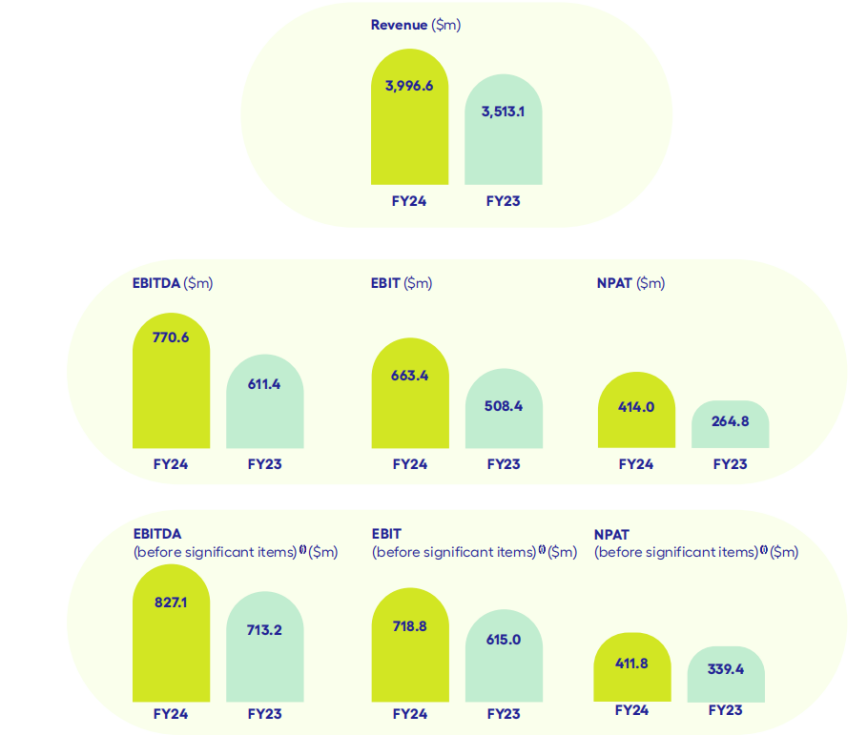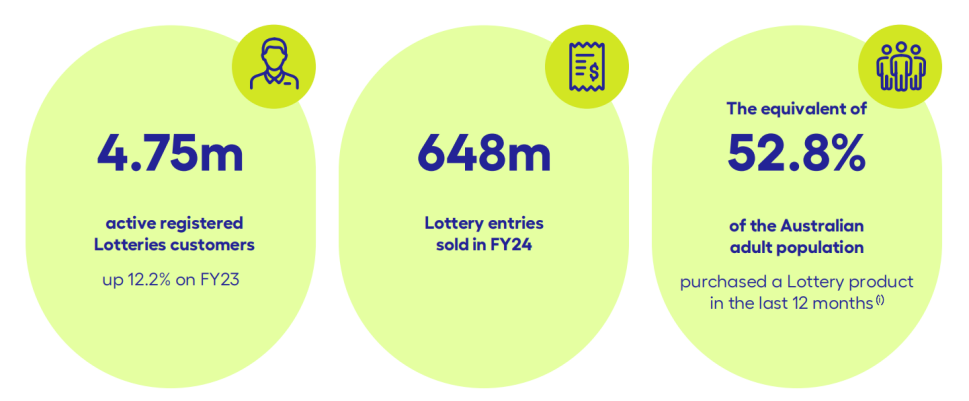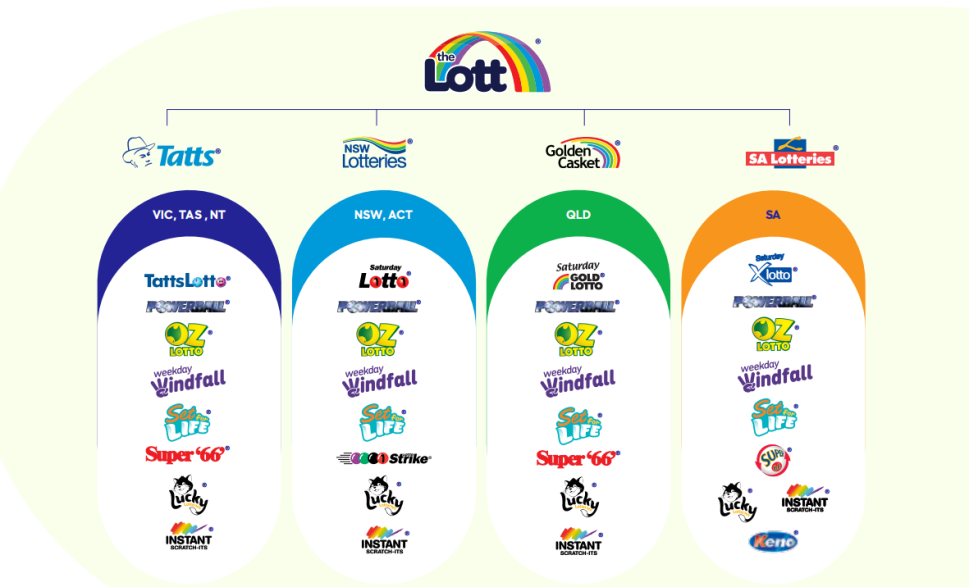The Lottery Corporation, an Australian lottery company, recently announced its revenue, with company revenue increasing by 14% to $4 billion, and EBITDA profit increasing by 1% to $827 million.
The company's active registered lottery customers grew by 500,000 this year, reaching a record 4.75 million users.
The Lottery Corporation (hereinafter referred to as The Lott) is an Australian company that operates through two divisions: the lottery games division and the keno games division, mainly providing various lottery games for operators.
The Lott primarily operates in Australia, with game brands including Set for Life, Powerball, Oz Lotto, TattsLotto, Saturday Lotto, Gold Lotto, X Lotto, Monday & Wednesday Lotto, Lucky Lotteries, Lotto Strike, Super 66, and Instant Scratch-Its.
In previous articles, we have sorted out the opportunities in the global lottery market and analyzed several famous lottery game providers worldwide. Related article: Global TOP9, making money while lying down on online lottery platforms! This niche track actually hides a fortune-making opportunity!
Today, with the help of this article, we will delve deeper into Australia's lottery game market, explore its essence, and see how The Lott has almost monopolized the entire Australian lottery market.
Australian Lottery Industry
Lotteries have a long history in Australia, dating back to the early 20th century.
The first recorded lottery in Australia was issued in 1881 by businessman George Adams, who introduced a lottery related to horse racing.
By the mid-20th century, various state governments in Australia began issuing their lotteries to fund public projects. For example, New South Wales issued its first lottery in 1931 to fund the construction of the Sydney Harbour Bridge. This set the foundation for other states to follow suit, making lotteries a popular way to raise funds for infrastructure and public services.
After decades of development, various state-run lotteries merged into what is now The Lott, becoming Australia's largest national lottery operator. The Lott manages iconic Australian lotteries such as Powerball, Oz Lotto, and TattsLotto. These games offer substantial prizes, often reaching hundreds of millions of dollars, making them very popular among Australians.
As the saying goes, "Lotteries are a tax on emotions."
When people have money, their overflowing consumer emotions lead them to increase their spending on lottery entertainment;
However, counterintuitively, when they face crises in life and their desperation rises, they are also likely to increase their lottery spending.
A 2022 survey by UBS found that only 44% of Australian respondents said that if living costs rose by 5%, they would either reduce their lottery spending by 5% (37%) or even stop buying lotteries altogether (7%).
However, 56% of respondents said that lotteries are a discretionary item, unaffected by overall income levels, and might even increase spending to "take a chance," so the economic cycle does not have a significant impact on the lottery industry, with a market downturn only about every five years.
Of course, the gambling business has always been considered a big business because "the house always wins."
But in terms of profit margins, lotteries have always been far ahead of other gambling businesses.
For example, the payout rate for the sports betting industry is 90%.
In other words, only 10% of the money bet by gamblers ultimately ends up in the pockets of betting operators. For casino slot machines, the payout rate is roughly 70%, with operators earning up to 30%.
However, the profit level of lotteries is the highest.
The payout rate for lotteries is usually about 50%, at most 60%, meaning that nearly half of the lottery prizes end up in the pockets of lottery merchants.
This amount is considerable, for example, in the United States, consumers spend up to $80 billion on lotteries each year. In comparison, the annual sales of movie tickets in the US are about $11 billion. In 11 of the 50 states in the US, the government earns more money from lottery sales than from corporate income taxes.
For Australia, the payout rate for The Lott-operated lottery games is 56%.
That is, for every 100 Australian dollars spent on lotteries, 56 Australian dollars are used to claim prizes. Surprisingly, about 2% of lottery winners never claim their prizes for various reasons, making the prize payout to revenue ratio about 44 to 56, close to 50/50, so the actual payout rate is roughly 55%.
Of the remaining 45 Australian dollars, 28 Australian dollars (i.e., 62% of the revenue) belong to the government as lottery taxes or gambling franchise fees.
From this, it can be inferred that The Lott's profit margin is about 17%, which is already higher than the overall profit margin of 10% (revenue minus payout rate) for sports betting, even without considering other costs.
It is evident that the lottery game is a lucrative business in any market, as we have already discussed in previous articles.
In this article, we focus on how The Lott operates and develops in Australia and provide a comprehensive and rich reference framework for industry players, allowing them to adopt its advantages through such a process.
The Lott: How to Play in the Lottery Industry!
First, we must mention The Lott's chairman, Steven Morro.
In December 2023, Mr. Morro officially took office as the non-executive director of the lottery company after obtaining the necessary regulatory approvals.
Morro has extensive experience in the gaming industry, having held multiple positions at International Game Technology PLC from 1988 to 2010, including President of North American Gaming from 2005 to 2007 and Chief Operating Officer from 2007 to 2008.
He served as a non-executive director of Aristocrat Leisure Limited from 2010 to 2020, including as the US Chief Director.
In 2022, he joined the board of Light & Wonder and joined The Lott in 2023.
With over thirty years of experience as a supplier, operator, and regulator in the strictly regulated gambling industry, Morro has been instrumental in directing the company's strategic development direction since joining The Lott, which has led to a significant revenue jump this year.
The Lott's financial performance for the 2023/24 fiscal year:
Revenue from the lottery division reached $3.7085 billion, up 14.7% year-on-year, with EBITDA of $724.5 million, up 19.3% year-on-year.
Revenue from the keno division was $288.1 million, up 2.7% year-on-year, with EBITDA of $102.6 million, down 3.2% year-on-year.
The company's revenue reached the $4 billion mark, and profits exceeded $800 million, setting new historical highs for revenue and customer growth.
The reasons for The Lott's high revenue include several key factors, the most important of which I summarize as—diversification of games and channels.
The profit margin mentioned above for The Lott is about 17%, which is the income after deducting prize payouts and government taxes.
This portion of the income is also shared with The Lott's channel partners.
For example, for lotteries sold or processed through retail stores, The Lott earns an EBITDA profit of 5 Australian dollars for every 100 Australian dollars sold.
For lotteries sold directly online to customers, The Lott earns an EBITDA profit of 15 Australian dollars for every 100 Australian dollars sold.
Here we can clearly see the difference, with an EBITDA profit margin of 15% for online sales and 5% for retail.
The profit from online lottery sales is three times that of physical store sales.
According to The Lott's data, currently, only 38% of their lottery sales are completed online, with the rest through 7,200 retail outlets.
Since 2018, The Lott's online sales have grown at an annual rate of about 2%, one important factor being the pandemic-driven digitization of society.
After Chairman Morro took over the company in 2024, the company accelerated its digitization progress, with online sales increasing by 5% in 2024.
Currently, the company's digital channel share accounts for 40.9% of total lottery sales, and the company is still increasing commissions for digital channel partners. The 38% of lottery sales have translated into 40.9% of sales, which is the confidence for the company to continue increasing commissions, also highlighting the advantages of digital channels.
According to the same UBS survey mentioned earlier, 56% of consumers spend more money once they buy lotteries online. Among them, 40% of people increased their spending on lotteries by more than 10%, a significant proportion indeed.
For The Lott, once the channels stabilize, its online sales are expected to maintain an annual growth rate of 2-3%, which is the most important aspect for the company.
Based on the scissors difference between lottery sales volume and sales, and the growth in online spending, every percentage point that online sales exceed retail sales increases the company's EBITDA by about 5 million Australian dollars.
According to estimates, the company's profit margin could increase from about 17% to 20%.
Considering that 86% of the Australian population owns smartphones, it would not be surprising if, in the long run, online lottery sales accounted for 60% of total sales, by which time the company's peak revenue would approach $5 billion, and net profits would exceed $1 billion. (This is even if the 4.75 million users do not grow, while Australia has over 8 million lottery users.)
It is clear that the online digital channel is undoubtedly the ace channel for lottery companies, whether it is settling on various operator websites or developing mobile applications, both are the best ways for lottery games to increase revenue.
Regarding users, the 4.75 million users that The Lott has acquired can be attributed to the company's development of a variety of lottery games.
The company manages multiple brand games such as Set for Life, Powerball, Oz Lotto, TattsLotto, Saturday Lotto, Gold Lotto, X Lotto, Monday & Wednesday Lotto, Lucky Lotteries, Lotto Strike, Super 66, and Instant Scratch-Its, and also has two divisions, lottery and keno games, continuously developing products and brands.
For example, the launch of the iconic Weekday Windfall lottery this year—an upgrade of Monday & Wednesday lotto, adding a Friday draw, a decision based on extensive consumer research by the company.
In addition, The Lott also planned the largest jackpot in Australian lottery history—a $200 million Powerball draw.
This lottery event attracted national attention, promoting the acquisition and activation of new and old customers.
At the same time, the company also held multiple "Weekday Windfall" lotteries and holiday draws, such as the $90 million Oz Lotto® draw on Boxing Day, the largest in over a decade.
All these brand activities aim to provide customers with an engaging gaming experience, which is why the company's user base has continued to grow steadily.
Of course, other strategies implemented by the company are also essential, such as the introduction of a new customer data platform, which allows the company to communicate with customers online in real time and improve the way customers are managed.
And once again, by maintaining the World Lottery Association's Level 4 certification—the highest level of certification awarded to lottery operators, the company has proven its commitment to the highest standards of responsible gaming, enabling stable and sustainable development.
Conclusion
After reviewing The Lott's data, we have once again demonstrated the high profitability of the lottery industry. Lotteries can be said to be the oldest form of gambling in the world and the most profitable. This industry is popular in every region globally.
This pie is virtually endless, and the key to getting a share in the highly profitable lottery industry is to meet the demands of the times and the expectations of users.
Embracing online digitization has become an inevitable trend. By optimizing user experience and expanding mobile platforms, lottery companies can increase their revenue and reach a broader, younger audience, especially the digitally savvy millennials.
Secondly, developing diversified games is the core of attracting and maintaining user loyalty. Through innovative gameplay and a rich variety of game types, lottery companies can not only provide more exciting entertainment experiences but also enhance user engagement, thereby driving continuous business growth.
The Lott has achieved these two points, allowing it to monopolize almost the entire Australian lottery industry. These two points are also key to our future success in entering the lottery industry.
We look forward to discussing more unique insights about the lottery industry with our readers and invite you to follow the global iGaming leader's outbound information platform PASA for more firsthand industry information on making a fortune.
Welcome to subscribe to the official PASA channel: https://t.me/PASAIGHYJL

















